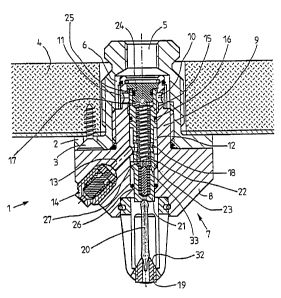Une partie des informations de ce site Web a été fournie par des sources externes. Le gouvernement du Canada n'assume aucune responsabilité concernant la précision, l'actualité ou la fiabilité des informations fournies par les sources externes. Les utilisateurs qui désirent employer cette information devraient consulter directement la source des informations. Le contenu fourni par les sources externes n'est pas assujetti aux exigences sur les langues officielles, la protection des renseignements personnels et l'accessibilité.
L'apparition de différences dans le texte et l'image des Revendications et de l'Abrégé dépend du moment auquel le document est publié. Les textes des Revendications et de l'Abrégé sont affichés :
| (12) Brevet: | (11) CA 2199803 |
|---|---|
| (54) Titre français: | CREPINE D'INCENDIE |
| (54) Titre anglais: | SPRINKLER |
| Statut: | Réputé périmé |
| (51) Classification internationale des brevets (CIB): |
|
|---|---|
| (72) Inventeurs : |
|
| (73) Titulaires : |
|
| (71) Demandeurs : |
|
| (74) Agent: | KIRBY EADES GALE BAKER |
| (74) Co-agent: | |
| (45) Délivré: | 2006-11-21 |
| (86) Date de dépôt PCT: | 1995-09-12 |
| (87) Mise à la disponibilité du public: | 1996-03-21 |
| Requête d'examen: | 2002-07-30 |
| Licence disponible: | S.O. |
| (25) Langue des documents déposés: | Anglais |
| Traité de coopération en matière de brevets (PCT): | Oui |
|---|---|
| (86) Numéro de la demande PCT: | PCT/FI1995/000495 |
| (87) Numéro de publication internationale PCT: | WO1996/008291 |
| (85) Entrée nationale: | 1997-03-12 |
| (30) Données de priorité de la demande: | ||||||
|---|---|---|---|---|---|---|
|
L'invention concerne une crépine d'incendie comprenant, en mode d'attente, un dispositif de déclenchement (20) sensible à la chaleur et placé en contact étroit avec une tige (15). Afin d'assurer la régularité et la rectitude de la charge s'exerçant sur le dispositif de déclenchement (20), ainsi qu'une pulvérisation régulière du liquide d'extinction sous forme de brouillard liquide, la crépine d'incendie est caractérisée par le fait que la tige (15) est montée dans un canal (12) possédant une entrée (10) de liquide et une sortie (13) vers des buses placées, de préférence obliquement, et s'appuie contre la paroi dudit canal (12), de façon pratiquement ou totalement coulissante, des deux côtés de l'entrée (10) de liquide, afin d'équilibrer la pression du liquide au niveau de ladite entrée, quand la crépine d'incendie est en mode d'attente et qu'une buse (27) dirigée vers le centre par rapport aux buses placées obliquement, se trouve à l'extrémité de la tige (15) en face du dispositif de déclenchement (20).
The present invention relates to a
sprinkler which in stand-by mode comprises
a heat-sensitive releasing device (20) in
close contact with a spindle (15). In
order to provide a new sprinkler which
ensures even and straight load on the
releasing device (20) and which also guarantees
even spreading of extinguishing liquid in the
form of liquid fog, the sprinkler is
characterized in that the spindle (15) is mounted
in a channel (12) with a liquid inlet (10)
and outlet (13) to preferably obliquely
positioned nozzles (14), and bears slidably or
almost slidably against the wall of the
channel (12) on both sides of the liquid inlet (10)
for balancing the liquid pressure at the
liquid inlet when the sprinkler is in stand-by
mode, and that a nozzle (27) centrally
directed in relation to the obliquely positioned
nozzles is provided at the end of the spindle
(15) which faces the releasing device (20).
Note : Les revendications sont présentées dans la langue officielle dans laquelle elles ont été soumises.
Note : Les descriptions sont présentées dans la langue officielle dans laquelle elles ont été soumises.

Pour une meilleure compréhension de l'état de la demande ou brevet qui figure sur cette page, la rubrique Mise en garde , et les descriptions de Brevet , États administratifs , Taxes périodiques et Historique des paiements devraient être consultées.
| Titre | Date |
|---|---|
| Date de délivrance prévu | 2006-11-21 |
| (86) Date de dépôt PCT | 1995-09-12 |
| (87) Date de publication PCT | 1996-03-21 |
| (85) Entrée nationale | 1997-03-12 |
| Requête d'examen | 2002-07-30 |
| (45) Délivré | 2006-11-21 |
| Réputé périmé | 2014-09-12 |
Il n'y a pas d'historique d'abandonnement
Les titulaires actuels et antérieures au dossier sont affichés en ordre alphabétique.
| Titulaires actuels au dossier |
|---|
| MARIOFF CORPORATION OY |
| Titulaires antérieures au dossier |
|---|
| SUNDHOLM, GORAN |